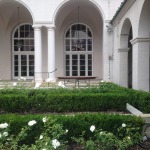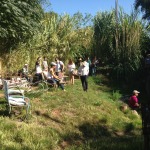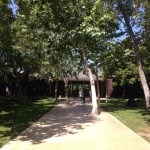Today was different. This morning I went out in my garden and watered for the first time in a month. I did a little pruning. Just a little … to remove the spent flowers from my favorite Poppy. I didn’t notice what was different at first, but I felt it. In fact, I didn’t realize what was different until just now.
It was quiet. There was no lawn mower choking into the morning. My neighbors diagonally across the street, the ones with a Saturday maintenance schedule, turned their lawn into a dry garden last week. It was a big shift for them, and for our neighborhood. It means one more family understands their landscape a little differently. It means we’ll have quiet weekend mornings from now on.
My landscape ethos came from two places: the women who raised me and the books that shaped me.
My mom let us pick our own Berry and Rose bushes to plant and tend to. My Grandma Mary grew Irises and Roses and Violets. My Grandma Felicité grew Mint and spent morning hours hand-weeding her lawn and ajuga. Carole, one of my second mothers, grew lilacs that filled her whole yard with fragrance. The Secret Garden introduced me to the possibilities of a garden as memory and a living being. I’ve always loved gardens that were full of flowers and places to discover.
But it isn’t a static thing. My landscape ethos has changed over time just as gardens do. The gardening I kept and books I read as I got older deepened my belief that my gardening was part of my bigger community. When Felicité died I planted a tree for her in my garden. And another for my great aunt. When Mary died I took Irises from her garden in New York and planted them in mine in North Carolina. Five years later they came with me to California.
The Foxfire Books provided a primer on self-sufficiency when I lived in the Appalachians. Raising kids and tending a huge yard turned me in desperation to The Lazy Gardener and its tips for working with nature instead of against it. Worry over waking my napping babies with loud lawn machines was one of the many reasons I was looking for a different way to garden. Cradle to Cradle and The Granite Garden turned my love of gardening with nature into a desire to design with nature. A year after I read them I was in graduate school.
My ethos continues to evolve as my understanding of myself and nature and design evolves. It is no surprise that people might need encouragement and guidance to understand the impacts their gardens and landscapes have on the world around them. So many of us came to where we live from somewhere else. And we brought the ideas of gardens (and often the plants) that we were raised with. For those who haven’t been educated in natural systems, or the beauty of lazy gardening, or the local climate, or the complexities of municipal water infrastructures this “brown is the new green” motto we have in Southern California might be confusing.
So, let us be kind.
Let’s be kind to those who water too much or prune too much or top their trees or blow away all the important nutrients from the soil they are trying to grow something in. Let’s be kind and patient and loving and simply show them a different way. It takes time to grow awareness and evolve perception of beauty. Almost as much times as it takes to grow a garden that defines it.
So let’s grow our dry and beautiful gardens to show our neighbors what’s what. They’ll notice the flowers … and the shade … and birds … and the butterflies … and the quiet … and maybe that you’re not doing that much. And then, when all the color and scent and life sinks in … they’ll notice the beauty. And they’ll want some of their own.











